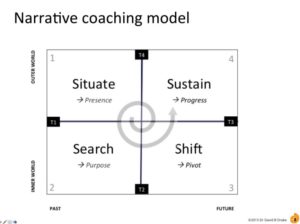Dr. David Drake
Coaching is an intervention in which the aim is to bring about change, clarity, or motivation in a client. In no case does one start coaching in order to try to start a therapy process, but the coaching process can be therapeutic in an indirect way.
In Dr. David Drake’s book, we are introduced to narrative coaching. In this style of coaching, the focus is on the story that the client brings to the session and how it affects, or gets in the way of, the achievement of goals.
On the premise that we live our own stories, what we tell ourselves, narrative coaching uses that same tool to generate transformation and awareness in those who attend the sessions.
The book begins with a summary of the theory that has led the author to be one of the creators of the coaching style. It is based on the narrative therapies that were developed in the late 1980s and early 1990s by schools of psychology. Dr. David Drake, having practiced this and coaching for a while, began to integrate them with great results. People live in their own stories. The way we tell this story to ourselves, the words, and what we give ourselves to understand directly affects what we do in our lives.
The book especially emphasizes the importance of presence when conducting sessions, and how the coach’s job is to remain present, and ready to help the client to move forward in the new stories that will emerge in the coaching space. The author shows a simple outline that he separates into four phases.

This model is quite useful, and can also be extrapolated with other terms that refer to other aspects of coaching, as can be seen in the graphic.
This outline permeates the whole book, so if you don’t like outlines to follow this might mean that this title is not 100% for you. However, as I read through it all, I realized that this scheme is designed around the narrative technique. The coach should help the client’s old stories, that which the client tells himself or herself or tells the world, into new stories that support growth. This is done by following the outline, even though the author himself emphasizes that at the moment of truth, everything appears organically. The coach uses this structure to accompany the client through the whole process, helping them to go deeper into their story and change as they live it.
On the other hand, one thing that caught my attention is that in this style it is recommended not to work with goals. Something that seems to be at the root of coaching is taken out of the equation. At first, I found the prospect of sessions going aimlessly a bit chaotic, as in my coaching training I learned that delimiting and working with goals was the right way to go. The argument Drake uses in his book is that really, we all “know” what we need or should do. The reasons for not realizing are in the story we tell ourselves about our situation. Therefore, as we work on the stories, the goals emerge organically.
In summary, I recommend this book, because it brings a unique perspective to the coaching session. Of course, each coach needs to develop his or her own unique style, and it is always wise to train and learn from experts… as long as you then reflect and adapt it to what works for you.




